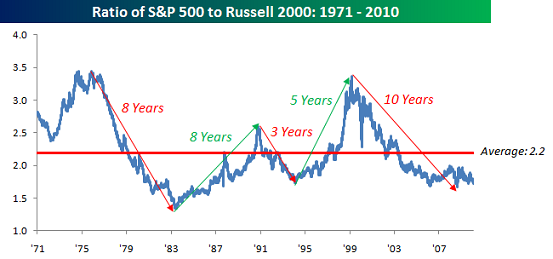Large Cap v Cap v Cap Mutual Funds
Post on: 4 Июль, 2015 No Comment

Large cap vs. mid cap vs. small cap. Whats the difference, and why does it matter to an asset allocation plan and a well diversified portfolio? These are important questions for every investor to answer. So first, lets talk about market capitalization, and then well talk about why it matters.
Market capitalization (or market cap, for short) is the value of all outstanding shares of a corporation. For example, if a company has 1 million shares outstanding that are trading at $100 per share, the companys market cap is $100 million. To put this in some perspective, the company with the largest market cap as of today is Exxon Mobil, which has a market cap of about $464 Billion (yes, thats billion with a b). In contrast, the smallest company on the S&P 500 is PMC-Sierra, Inc. which has a market cap of $1.6 billion. And there are many, many public companies with a market cap of less than $1 billion.
Now, why does it matter? Well, history tells us that, on the whole, investing in smaller companies is riskier than investing in larger companies. That seems sensible. Smaller companies dont have the financial resources of many larger companies to weather a financial storm. And the products or services of smaller companies are often still unproven.
As we saw with stocks vs bonds. the higher risk involved with investing in smaller companies has, historically, resulted in higher returns. From 1926 to 1998, for example, large company stocks had an annualized return of 11.22%, while small company stocks enjoyed an annualized return of 12.18%. If you think this nearly 1% difference is not all that much, check out How Half a Percent Can Ruin Your Retirement .
All of this still leaves open an important questionHow big (or small) must a company be to be considered a large cap (or small cap) stock? There is no single answer to this question. Morningstar considers the largest 5% of the stocks in its database as large cap, the next 15% as mid cap, and the remaining 80% as small cap. Morningstar uses the familiar and convenient Style Box to indicate the market cap of an individual stock or mutual fund.
Here is another commonly used division of market cap, which breaks the size of a company into six categories:
- Mega Cap: $200+ billion
- Big/Large Cap: $10 200 billion
- Mid Cap: $2 $10 billion
- Small Cap: $300 million $2 billion
- Micro Cap: $50 $300 million
- Nano Cap:














